
- Magazine Première Édition
- Distribution
- Format
- Broché (15)
- Broché, Physique (2)
- Couverture Souple (3)
- Dvd (2)
- Hardback (23)
- Hardcover (17)
- Livre Broché (2)
- Livre De Poche (6)
- Magazine (16)
- Numéro Unique (11)
- Paperback (19)
- Paperback, Physical (6)
- Physical (461)
- Physique (79)
- Reliure Rigide (2)
- Relié (31)
- Single Issue (6)
- Softcover (4)
- Trade Paperback (2)
- Autre (3213)
- Genre
- Action & Adventure (20)
- Actualités (12)
- Art & Photographie (30)
- Art & Photography (65)
- Art Et Photographie (13)
- Celebrity (18)
- Fashion (26)
- Gonzo (12)
- Histoire (41)
- History (49)
- Hommes (24)
- Horreur & Monstre (16)
- Horror & Monster (24)
- Jeux Vidéo (18)
- Manga & Anime (14)
- Men (33)
- Mode (22)
- Music (20)
- Sports (36)
- Video Games (40)
- Autre (3387)
- Langue
- Pays D'origine
- Signé
Rare Réimpression Vintage de la Première Édition du Magazine Ring de Boxe, 15.02.1922
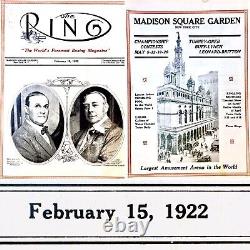
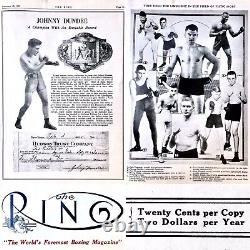
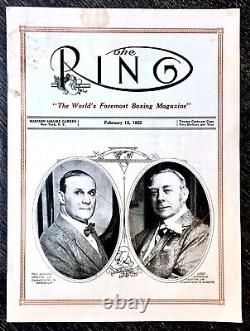

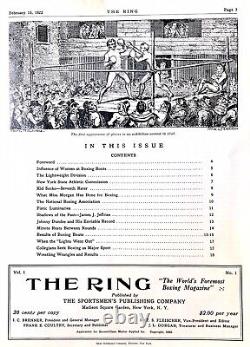
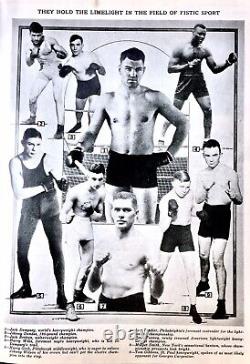
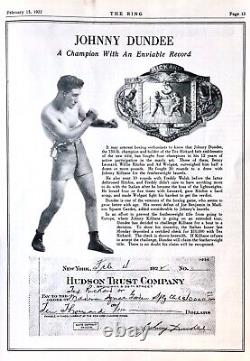
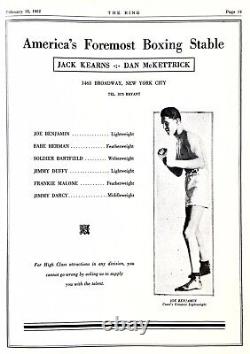

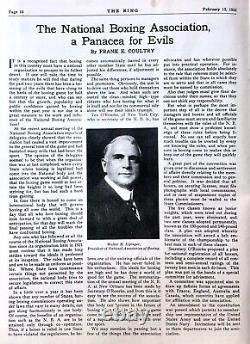
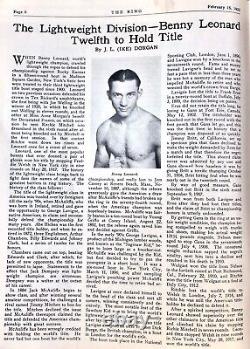
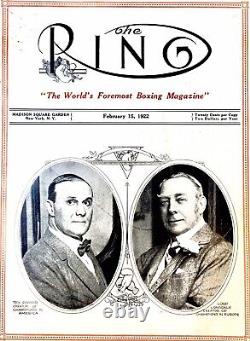


Rare Official Original 1990 Reprint of The First Ever Edition of Boxing's Ring Magazine (February 15th 1922, Size: 10.5"/27cm x 8"/20cm). Rate opportunity for you to acquire a marvellous piece of boxing history. On the front cover are pictures of Tex Richard, and Lord Lonsdale.
Inside various articles including photograph of Jack Dempsey etc. This is an exact duplication of very first copy of the enduring boxing magazine, issued by the publishers of the original magazine.
I believe the only difference being the size as the original February 1922 version was 9"x12" whilst the official reprint was 8"x10.5" in size. This magazine is an exact copy of an original 1st issue, uncommon in its own right, of the February 15, 1922 maiden issue of The Ring. Wonderful period articles and photos throughout. Madison Square Garden, New York, The Sportsmen's Publishing Company, 1922. The Ring has had five owners throughout its history: Nat Fleischer and family, Dave DeBusschere and Nick Kladis, Stanley Weston, Nick Karabots, and now Oscar De La Hoya.
Fantastic rare reprint of the original magazine. Please browse all 12 sets of photographs attached for details and condition as they are self explanatory. There are a couple of age related watermarks but that's part it's in good order so please enlarge and study all the photographs as what you see will be exactly the item you'll receive. The Ring magazine is widely known as the bible of boxing. It's an institution from the USA with information on world boxing news that extends beyond the norm of interviews with boxing stars and bout reviews. There have been only eight editors-in-chief in the magazine's history.Doug Fischer is the current editor. The Ring began awarding championship belts in 1922. The first Ring belt was awarded to heavyweight champion Jack Dempsey, the second to flyweight champion Pancho Villa. Ring Magazine championships are one of the most cherished titles in all of sports. Not only do winners separate themselves from the slew of fighters holding alphabet world titles, but the belt also usually signifies the wearer as the very best fighter in the division.
There are four recognised major bodies in boxing, the WBA, WBC, IBF and the WBO. The Ring title is awarded by American boxing magazine, The Ring, and has been done since 1922.
The Ring (often called The Ring magazine or Ring magazine) is an American boxing magazine that was first published in 1922 as a boxing and wrestling magazine. As the sporting legitimacy of professional wrestling came more into question, The Ring shifted to becoming exclusively a boxing-oriented publication.
The magazine is currently owned by Oscar De La Hoya's Golden Boy Enterprises division of Golden Boy Promotions, which acquired it in 2007. Ring began publishing annual ratings of boxers in 1924.
The Ring, founded and published by future International Boxing Hall of Fame member Nat Fleischer, has perpetrated boxing scandals, helped make unknown fighters famous worldwide and covered boxing's biggest events of all time. Dan Daniel was a co-founder and prolific contributor to The Ring through most of its history. It refers to itself (and is referred to by others) as The Bible of Boxing. " During the Fleischer years, the contents page or indicia of every issue carried the claim: "The Ring is a magazine which a man may take home with him. He may leave it on his library table safe in the knowledge that it does not contain one line of matter either in the text or the advertisements which would be offensive. The publisher of The Ring guards this reputation of his magazine jealously. It is entertaining and it is clean. In 1972, following Fleischer's death, his son-in-law and managing editor Nat Loubet took over as publisher. In 1977, Loubet launched three international editions of the magazine.The Spanish version, Ring En Español, was published in Venezuela and distributed to all Spanish-speaking countries and the United States U. There was also a Japanese version published in Tokyo and a French version published in Paris. In 1976, managing editor of The Ring Johnny Ort, fabricated records of selected boxers, and elevated their rankings, securing them lucrative fights on the American ABC television network, as part of the United States Championship Tournament orchestrated by promoter Don King.
The deception was uncovered by boxing writer Malcolm "Flash" Gordon and ABC staffer Alex Wallau and the United States Championship tournament was cancelled by ABC. In 1983 Sugar was succeeded by future New York boxing commissioner Randy Gordon. Nigel Collins of the Ring's defunct sister magazine Boxing Illustrated took over as editor. London Publishing (later known as Kappa Publishing Group), which also published KO Magazine and a number of wrestling publications. KO senior writer Steve Farhood became The Ring's editor.He not only resurrected the magazine from its imminent collapse, he re-established the publication as the definitive source for boxing news. An outstanding boxing artist, Weston painted 57 covers for The Ring with his first cover, a painting of Billy Conn, for the December 1939 issue. Weston was also a photographer who, according to his own estimate, shot over 100,000 boxing photos?
The majority of which are housed in the archives of The Ring magazine. Sports and Entertainment Publications, LLC, a subsidiary of Oscar De La Hoya's Golden Boy Enterprises, acquired The Ring, KO Magazine, and World Boxing in 2007.
The magazine's rankings are recognized as "official" by some in the U. While some may see a conflict of interest in a boxing promoter being paymaster of what is essentially a magazine/rankings organization that awards world titles and belts, De La Hoya says that is not the case. "These magazines will be held in an editorial trust where they will be operating totally independent of any influence from me or others from the Golden Boy Companies as it relates to editorial direction or content". Also there is a 35-member ratings advisory panel, which include many of the media that cover boxing, who would prevent Golden Boy Promotions from using the magazine for self gain.The Ring was headquartered in Blue Bell, Pennsylvania until 2011 when it was relocated to Los Angeles. The magazine had a sister publication named The Ring Wrestling which came about due to professional wrestling writer Bob Leonard contacting the magazine and expressing that it was too focused on boxing and not giving wrestling enough coverage. Nat Loubet served as the editor of the wrestling magazine as well. The Ring has its own championship belt in a given weight class where The Ring champion holds a linear reign to the throne, the man who beat the man.
The first Ring world title belt was awarded to heavyweight champion Jack Dempsey and the second was awarded to flyweight champion Pancho Villa. The Ring stopped giving belts to world champions in the 1990s, then reintroduced their titles in 2002. The Ring stated that their title was "intended to reward fighters who, by satisfying rigid criteria, can justify a claim as the true and only world champion in a given weight class".
